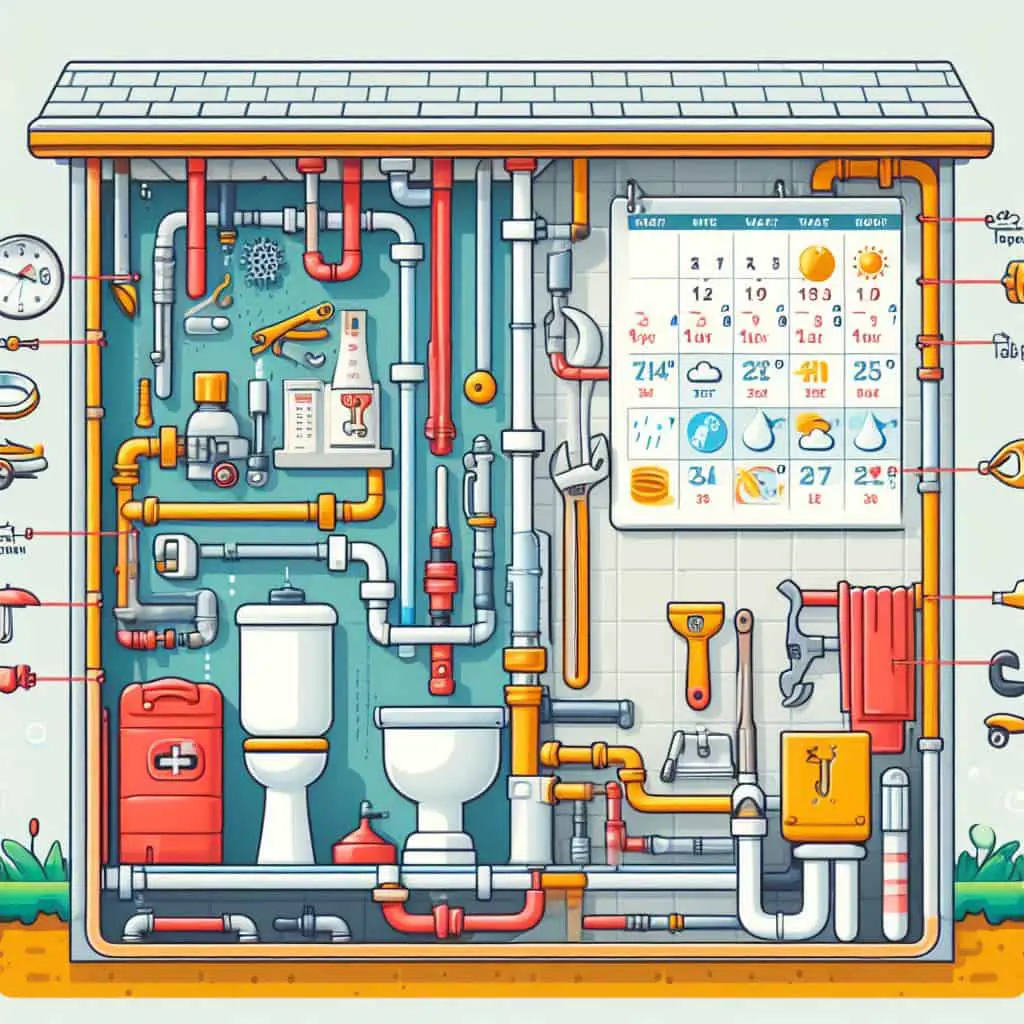You’re about to become your bathroom’s plumbing hero, no matter the season! Whether you’re spring cleaning your drains, prepping your sump pump for summer, insulating pipes in the fall, or winterizing your water system, we’ve got you covered.
With our year-round plumbing upkeep tips, you’ll tackle each task with confidence. Say goodbye to costly repairs and hello to a well-maintained bathroom—let’s dive into keeping your plumbing in top shape all year long!

Key Takeaways
- Regularly clean sink and tub drains to prevent clogs and maintain flow
- Ensure sump pump is functioning correctly to prevent flooding
- Insulate exposed pipes in unheated areas to prevent freezing and bursting
- Take preventative measures to winterize the water system and protect outdoor faucets and lines
Spring Cleaning Your Drains
As spring’s arrival ushers in the season of renewal, it’s essential that you give your bathroom drains a thorough cleaning to prevent clogs and maintain proper flow.
Start with your sink and tub drains, which often collect hair and soap scum. Wear gloves and remove any visible debris using a drain snake or a bent wire hanger.
Next, flush the drains with boiling water to dissolve any residual buildup.
For a deeper clean, mix equal parts of baking soda and vinegar, pour it down the drain, and let it fizz for a few minutes. This natural combo breaks down grime without harsh chemicals. Rinse it away with more boiling water for a clear path.
Don’t forget to check your toilet’s flush too. A slow drain could indicate a clog lurking further down the line.
Lastly, inspect the pipes under your sink for leaks or damage. Tighten any loose connections and replace worn-out components if necessary.
Regular maintenance like this keeps your bathroom plumbing in top shape and saves you from unexpected repair bills.
Embrace the spring spirit and start this season with a fresh, fully functional bathroom.
Summer Sump Pump Strategies
During the summer, you’ll want to ensure your sump pump is functioning correctly to prevent any potential flooding from seasonal storms. Heavy rain can result in excess water that your sump pump must handle efficiently.
Start by checking the pump’s operation. Pour water into the pit to trigger the pump. If it doesn’t activate, troubleshoot immediately—check the power source and float switch for any issues.
Inspect the discharge line. It’s crucial to confirm there are no blockages or kinks that could impede water flow. Clear any obstructions and secure loose parts to ensure a smooth operation. Also, consider installing a backflow preventer to stop water from re-entering your basement.
Don’t overlook the backup system. Summer storms often bring power outages, and without power, your sump pump won’t operate. Investing in a battery backup or a water-powered sump pump ensures protection during electricity failures.
Lastly, keep an eye on the forecast and test your pump regularly, especially before a predicted heavy downpour. Regular maintenance checks, including cleaning the sump pit of debris, will prolong the life of your pump and reduce the likelihood of malfunctions when you need it most.
Fall Pipe Insulation Practices
You’ll need to insulate your pipes before the first cold snap to prevent them from freezing and potentially bursting. As fall rolls in, temperatures drop, and your bathroom’s plumbing becomes vulnerable to the cold, taking proactive steps to safeguard your pipes can save you from costly repairs and inconvenience.
Here’s what you need to focus on:
- Identify exposed pipes: Start by locating any plumbing that’s not insulated, particularly in unheated areas such as basements, attics, and garages.
- Choose the right insulation: Pipe foam insulation sleeves or wrapping are excellent choices. Make sure it’s appropriate for the size and type of your pipes.
- Seal all gaps: Use caulk or spray foam to seal cracks and openings near your pipes to keep cold air out.
- Insulate outdoor faucets: Don’t forget to protect outdoor spigots with covers or by wrapping them in insulation materials.
By following these steps, you’re not just preparing for fall; you’re also ensuring that your bathroom’s plumbing will withstand the harsher winter weather ahead.
Winterizing Your Water System
With the arrival of winter, it’s crucial that you drain and shut off exterior water lines to prevent freezing and bursting. Pipes filled with water can freeze, expand, and break, potentially causing significant damage to your home. You need to take action before the cold really hits.
Detach your garden hoses, and store them safely indoors. Then, locate the shut-off valves for your outdoor faucets and turn them off. Drain the remaining water from the lines by opening the outdoor faucets until they run dry. Insulate any exposed plumbing to keep it from freezing.
Remember that your indoor pipes need attention too, especially those in unheated areas like garages or basements. Wrap them with insulation sleeves or heat tape to defend against the cold. Here’s a quick emotional guide to why this matters:
| Feeling | Cause | Prevention |
|---|---|---|
| Relief | No burst pipes | Insulate & heat tape |
| Peace | No costly repairs | Regular checks |
| Joy | Reliable winter plumbing | Professional inspection |
Don’t let winter catch you off guard. By taking these steps, you’ll enjoy the comfort of a fully functional home plumbing system all season long.
Year-Round Plumbing Upkeep
Beyond winterizing, there are several key practices you should regularly follow to ensure your bathroom’s plumbing remains in top condition year-round.
Your bathroom is one of the most frequently used areas of your home, and it requires ongoing attention to keep everything flowing smoothly. Here’s what you’ll want to keep on your checklist:
- Regularly Inspect for Leaks: Check under the sink, behind the toilet, and around the shower for any signs of leaks or moisture. Catching a leak early can prevent costly repairs and water damage.
- Clean Drains and Overflows: Use a natural drain cleaner or a plunger to clear out any clogs before they become severe. Don’t forget to clean the overflow holes in your sink and bathtub to prevent water from spilling over.
- Test Water Pressure: Low pressure can be a sign of sediment build-up or more serious plumbing issues. Make sure your water pressure is consistent and address any changes promptly.
- Seasonal Faucet Aerator Cleaning: Unscrew and clean your faucet aerators to remove any build-up of sediment or scale that could affect water flow.
Conclusion
Keep your bathroom’s plumbing in top shape year-round. Regularly clean your drains in the spring. Check your sump pump in the summer.
Insulate pipes during the fall. Winterize your water system before the cold hits. Stick to these seasonal strategies and don’t forget ongoing maintenance. By doing so, you’ll prevent costly repairs and ensure your bathroom is always ready to handle whatever the weather throws at it.
Stay proactive and your plumbing will thank you.
